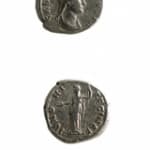Silver Denarius of Empress Sabina, 120 CE - 136 CE
Silver
C.5500
Further images
Obverse: SABINA AVGVSTA; Diademed and Draped Bust of the Empress Facing Right Reverse: IVNONI REGINAE; Juno Standing to the Left, Holding a Patera and a Sceptr In 100 A.D., Sabina...
Obverse: SABINA AVGVSTA; Diademed and Draped Bust of the Empress Facing Right
Reverse: IVNONI REGINAE; Juno Standing to the Left, Holding a Patera and a Sceptr
In 100 A.D., Sabina married the future emperor Hadrian at the age of twelve. The marriage, however, does not seem to have been a particularly happy one considering that Hadrian was openly homosexual. Unfortunately, Sabina did not seem to possess the ability to overlook her husband's sexual practices, as most of the imperial women found it expedient to do. She played the part of the dutiful wife, though, even accompanying Hadrian and his lover Antinous on their tour of Egypt. Upon her death in 136 A.D., rumors began to spread that Hadrian had poisoned her because she was resentful of his homosexual relationships. However, these accusations are senseless when one figures that Hadrian was a frail old man at the time of her passing (Hadrian himself would die the next year). It is quite unlikely that he would murder her at this late a date after thirty-six years of marriage, however fulfilling they might have been.
How many hands have touched a coin in your pocket or purse? What eras and lands have the coin traversed on its journey into our possession? As we reach into our pockets to pull out some change, we rarely hesitate to think of who might have touched the coin before us, or where the coin will venture to after it leaves our hands. More than money, coins are a symbol of the state that struck them, of a specific time and location, whether contemporary currencies or artifacts of a long forgotten empire. This stunning hand-struck coin reveals an expertise of craftsmanship and intricate sculptural detail that is often lacking in contemporary machine-made currencies. Hadrian the Emperor is famed for the numerous construction projects undertaken during his reign, many of which survive today in ruins spanning across western Europe. However, an artifact such as this coin paints a different portrait of Hadrian as a human and husband seen through the eyes of his devoted wife. So alas the memory of Sabina will live on in this intimate memorial passed from the hands of civilization to civilization, from generation to generation that appear as vibrant today as the day they were struck.
Reverse: IVNONI REGINAE; Juno Standing to the Left, Holding a Patera and a Sceptr
In 100 A.D., Sabina married the future emperor Hadrian at the age of twelve. The marriage, however, does not seem to have been a particularly happy one considering that Hadrian was openly homosexual. Unfortunately, Sabina did not seem to possess the ability to overlook her husband's sexual practices, as most of the imperial women found it expedient to do. She played the part of the dutiful wife, though, even accompanying Hadrian and his lover Antinous on their tour of Egypt. Upon her death in 136 A.D., rumors began to spread that Hadrian had poisoned her because she was resentful of his homosexual relationships. However, these accusations are senseless when one figures that Hadrian was a frail old man at the time of her passing (Hadrian himself would die the next year). It is quite unlikely that he would murder her at this late a date after thirty-six years of marriage, however fulfilling they might have been.
How many hands have touched a coin in your pocket or purse? What eras and lands have the coin traversed on its journey into our possession? As we reach into our pockets to pull out some change, we rarely hesitate to think of who might have touched the coin before us, or where the coin will venture to after it leaves our hands. More than money, coins are a symbol of the state that struck them, of a specific time and location, whether contemporary currencies or artifacts of a long forgotten empire. This stunning hand-struck coin reveals an expertise of craftsmanship and intricate sculptural detail that is often lacking in contemporary machine-made currencies. Hadrian the Emperor is famed for the numerous construction projects undertaken during his reign, many of which survive today in ruins spanning across western Europe. However, an artifact such as this coin paints a different portrait of Hadrian as a human and husband seen through the eyes of his devoted wife. So alas the memory of Sabina will live on in this intimate memorial passed from the hands of civilization to civilization, from generation to generation that appear as vibrant today as the day they were struck.





